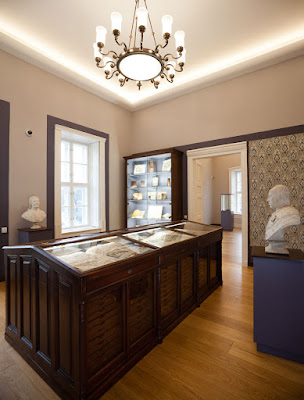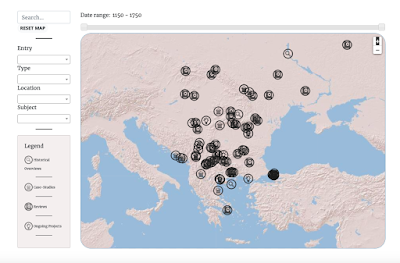
The year 2022 marks the 800th anniversary of the issuance of the Golden Bull by King Andrew II. Issued at the 1222 Diet held at Fehérvár, the Golden Bull is one of the cornerstones of the medieval Hungarian constitutional system and its anniversary created a perfect opportunity to organize a major exhibition dedicated to Hungary's first ruling house, the Árpád Dynasty. Such an exhibition has been planned for at least a decade and curators at the Hungarian National Museum have prepared a proposal for a major exhibition with international loans. In 2017 government support came, along with the decision that the exhibition should be held at Székesfehérvár, to mark the anniversary of the Golden Bull and to inaugurate a newly renovated museum building belonging to the King Saint Stephen Museum. Curators were appointed from both institutions and the long work of securing loans and preparing a catalog was began. At the beginning of 2019 a new government-funded institution, the Institute of Hungarian Research started its operations. The Minister of Human Resources (in charge of cultural affairs) delegated this Institute to the consortium preparing the exhibition. Work continued and the scheduled date of opening was nearing - although the renovation of the Székesfehérvár museum building was not yet completed.
 |
| Installation view |
Then late in December of 2021, Miklós Kásler, Minister of Human Resources - in agreement with the newly appointed director of the Hungarian National Museum, László L. Simon - announced in an email that the appointment of the curators (Etele Kiss, Ágnes Ritoók, and Erika Simonyi of the Hungarian National Museum) is being withdrawn, and Miklós Makoldi of the Institute of Hungarian Research is appointed as the new curator of the exhibition. Making such a move three months before the opening of a major exhibition is quite surprising even in Hungary and naturally, a scandal broke out. Given the fact that Miklós Makoldi, an archeologist without a doctorate and any relevant museum-related expertise was about to take over the results of three years of work by a team of experienced museum curators, many scholars decided that they no longer wish to participate in such a project. In the end, 25 scholars signed an open letter, withdrawing their contributions from the catalog of the exhibition (which was already nearing completion). In this situation, many people doubted that the exhibition could be opened at all. In the end, the exhibition - titled Kings and Saints, The Era of the Árpád Dynasty - opened on March 18, 2022, in a former monastery turned into a museum at Székesfehérvár. Due to the circumstances, however, the result amounts to a monumental missed opportunity.
 |
| The Monomachos Crown (Hungarian National Museum) |
Let me explain in detail. Makoldi, the new curator of the exhibition, had no chance or time to change the concept of the exhibition. He only modified three rooms of the exhibition, mainly to remove references to the non-Hungarian population of medieval Hungary (including Carolingians and Slavs from the first section dealing with the Hungarian conquest and a chapter about Muslims, Jews, and various Eastern nomadic people living in the Kingdom of Hungary). You can read the explanation of the Institute and see for yourself. In any case, the new curator worked with the original synopsis and object list - taking over other people's work, if you will. However, the original concept could not be realized. Several important loans did not make it to Székesfehérvár (the Cross of Adelheid from Lavantall is one such object mentioned in the press, but there are many others). It is hard to tell what role the scandal played in the case of missing loans - I think the venue in Székesfehérvár may also have played a role in this. Not the address itself, but the fact that the museum building in Székesfehérvár was completed just a few weeks before the opening of the exhibition, so lenders could not verify that it is up to international standards needed for sensitive objects.
 |
| Lehel's horn from Jászberény |
 |
| Enklopion from Maastricht |
The exhibition mounted with the remaining objects still contains many highlights and presents a good overview of Árpád-age Hungary. According to the original concept, the objects are arranged in 17 sections, ranging from the period of the Hungarian Conquest to an overview of saints from the Árpád Dynasty. The
website of the exhibition (a work in progress at the time of writing) lists the chapters. Many of the highlights - the Monomachos Crown, the crown with lilies from Margaret Island, or some stone carvings - come from the Hungarian National Museum. There are important objects from Székesfehérvár and other Hungarian museums (such as the Lehel's horn/olifant from Jászberény). A number of recent archaeological finds - such as a reliquary and other
finds from Pétermonostora - are on view. There are numerous foreign loans as well: the sword of Saint Stephen from Prague, stone carvings from former monasteries now located in Serbia or Romania, important manuscripts from various libraries, a flag with the double-cross of the Árpád Dynasty from Bern, or even the tombstone of the Blessed Elisabeth of Töss, daughter of King Andrew III (from the Landesmuseum in Zürich). True highlights, such as the 12th century double cross in the Dommuseum of Salzburg and especially the highly sophisticated 13th-century court goldsmith works (the Zaviš-cross, the cross made from diadems in Cracow or the Bern (Königsfelden) diptych) are sadly missing from the exhibition. Granted, such loans are extremely hard to secure and not all of these objects were even envisioned in the original scenario of the exhibition - but such an exhibition is a one-time chance in a generation and this chance was sadly missed.
 |
| A display of stone carvings |
The exhibition also does not take advantage of being in Székesfehérvár. Although there are references to the royal basilica dedicated to the Virgin - the coronation church and most important burial place of Hungarian kings - the actual site of the church was closed at the time of my visit (although supposedly it is open daily from April 1st). The highly important Árpád-period stone carvings from this church remain largely inaccessible - a museum scheduled to become their new home will open only by the end of the year.
 |
| Finds from Pétermonostora |
Moreover, it is obvious that the new curator and his team scrambled to put the exhibition together in the three months at their disposal. As there is no list of the exhibition team, it is hard to tell who did what, but two weeks after the opening day, the exhibition looked half-finished. All the rooms are darkly lit (even rooms with stone carvings and goldsmith objects), the object labels are quite impossible to read and some of them are even missing. Some key objects are placed in dark corners or close to the floor, or at the back of large showcases. The larger exhibition graphics are unnecessary and badly designed in general: a section of the Bayeaux tapestry stands in to illustrate 11th-century battles in Hungary, the Legend of Saint Ladislas from the Hungarian Angevin Legendary was adapted to a graphic of a fake medieval stained glass window series, some kings lifted from the 14th-century Illuminated Chronicle are mislabeled, etc. There is no explanation for the complete lack of any information in English in the exhibition. There are some interactive video screens - but no new content was developed for them, they simply show films recycled from other venues and exhibitions. Of course, there is no catalog in any language or any publication whatsoever, due to the lack of authors (see above). All this makes it impossible to reach any kind of international impact with the exhibition All this despite the 506 million HUF (about 1,3 million euros) budget from government support dedicated to the exhibition. A missed opportunity, indeed.
 |
| 13th-century crown from Margaret Island, HNM |
Despite these significant shortcomings, do visit the exhibition if you get a chance. Objects that are otherwise hard to see and some highlights are definitely worth a visit. The original concept of the exhibition can still be followed (as long as you read Hungarian...) and Székesfehérvár is only about 45 minutes from Budapest by train. The exhibition will be on view until June 15, 2022.
 |
| Fragments from the tomb of Queen Gertrude, from Pilis Abbey |
 |
| 14th-century reliquary of St. Stephen from Aachen |
(photos my own, taken with permission)















































